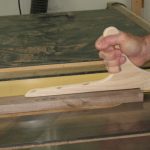We may receive a commission when you use our affiliate links. However, this does not impact our recommendations.
Just got this month’s PW and in it was a letter to the editor about preventing rust. Megan answered saying use was an excellent means of rust prevention, regular oiling, and for long term storage, petroleum jelly is a good idea. All good answers, but in my opinion, missing a few details:
Climate control:
If you have a humid shop, you are going to get rust. So control your humidity! Consider using a dehumidifier (basically an air conditioner) to control the humidity in your shop, even when you’re not working there. Expensive you say? Let me ask you: How much did you pay for that set of Lie Nielsen chisels again? What about your planes? Wenzloff saws? Carving tools? Antique moulding planes you paid extra for because they were in good shape? How long did it take you to find that pristine bedrock #8 again? You get the message. If you have nice tools, you have to take care of them. You may be surprised how little it costs to run a dehumidifier.
Micro climates:
Air conditioning the entire shop isn’t the only way to control humidity. Consider creating a micro-climate – a shop within your shop. That’s right, maybe it’s time to build yourself a toolchest. I know wall racks are all the rage. You can display your tools like the Lee Valley Booth at Woodworking in America. But an old fashioned toolchest with a tight fitting lid goes a long way to controlling humidity. Why? Because you can create a micro climate inside it, different from the climate outside. Add silica jell packs that came with your new shoes, Lee Valley sells them as well, or a Goldenrod. A Goldenrod is nothing more than a heater that keeps water vapor from condensing on your tools.
Or consider moth balls. Camphor or moth balls give off a gas that interferes with oxidation. Corrosion inhibiting paper does something similar. I think both of these work best in hermetically sealed environments. If you have a set of center bits you use infrequently or hope to sharpen next year, drop them in a zip lock bag with a moth ball. It’s not a guarantee, but it will help.
Keep a clean shop:
We know that household dust and wood dust are hygroscopic – they absorb water. So dusty tools will likely corrode faster than clean tools. Using tools is a good way to keep them clean, as Megan mentioned. But there are other things woodworkers should do.
1) Never put a plane away with shavings in it’s mouth. That’s just asking for trouble. And don’t blow the shavings out like I do. Our breath is very humid. Clean them out properly. Yank out the blade and wipe it on a strop or oily cloth.
2) Forget Schwarz’ hybrid woodshop. Hand and power tools don’t mix. Kelly Mehler has a machine room to die for, but the hand tools are upstairs. If you must use sanders or planers in the same area as your hand tools, consider storing them elsewhere (I think a toolchest makes an awesome coffee table for the living room). Or listen to Kelly. We’re killing ourselves with wood dust. Spend some cash on a high quality dust collection system. (Kelly’s filters to half a micron) We’re willing to spend big money on tools that will hurt us and unwilling to spend on tools that protect us (Safety glasses, good dust masks, dust collection systems, saw stop, etc).
Coatings that help and coatings that don’t:
No one rust prevention coating will work for all situations. A thin film of a non-oxidizing oil (mineral oil, 3-in-1 oil (mineral oil), Starrett precision tool oil (mineral oil) , or Norton’s special honing fluid (mineral oil)) is an excellent rust inhibitor. Two other slightly controversial choices are motor oil (I like Mobil 1 synthetic oil because I use it in my cars and it doesn’t gum up over time) and WD-40 (see Brownell’s test here) But in dusty environments, oils will also attract dust which we know leads to rust. There are spray on rust inhibitors like Birchwood Casey’s Dri-touch or Boeing’s BoeShield T-9 which dry to form a waxy surface that doesn’t attract dust so readily. Getting sprays to really cover can be an issue. Ditto for heavy greases like petroleum jelly or cosmoline. But grease is a simple, effective, and inexpensive way to protect your tools. Just apply it liberally and protect the surface from contact with dust, wood, etc.
Recapping, if rust is a concern (and it should be):
1) Control the humidity first. Add air conditioning to the shop, run it even when you are not in it. Or build a traditional toolchest and control the humidity inside it.
2) Control the dust in your shop. Use a HEPA filter on your vac, store your hand tools elsewhere if necessary. If you thought dust collection was a luxury item, reconsider for the sake of your tools if not your own health.
3) Coatings are not a panacea and they shouldn’t be your only effort to inhibit rust. Rather, choose coatings based on the sort of storage: long term, no use, consider grease, short term, high use, paste wax, mineral oil, or WD-40. Consider how easily they are applied and removed (watch out for coatings containing Silicone which is known to interfere with certain finishes and glues).
4) Last, know that no single right answer will serve everyone. Each situation is different, each person is different. Some of us have a bit more corrosive perspiration that others. Rust can only be kept at bay by a concerted effort involving regular treatment, and environmental controls. Fortunately, these controls will make your shop a nicer, safer place to work. And now you have one more excuse to start building that traditional toolchest you’ve been wanting to build.
Here are some supplies and tools we find essential in our everyday work around the shop. We may receive a commission from sales referred by our links; however, we have carefully selected these products for their usefulness and quality.









Adam
you seem to have comments closed on your latest entry so I will try and ask here!
You mention “Most woodworkers don’t have or use any of the tools I consider absolute necessities”
Do you have a list of what you consider essential?
Cheers
David
Adam, an excellent review of the care of tools. Particularly the effects of climate change over the seasons in the shop.
A bit of past knowledge sometimes helps, wax works well and avoiding propellants is a good thing. Silicon is not nice stuff. All great points made in the post and the comments!
As for tool chests, unless you’re going to build an hermetically sealed one with it’s own AC unit (now, there’s a thought), it’s just a place to store your tools. Chest, cabinet, box, it’s just a storage box.
I apply a mix of beeswax and carnauba to tools going into storage and that’s about it. Camphor makes me sneeze.
Sometimes we’re just overthinking things?
Don, you’re right, I’m wrong. Rereading, Tri-flow contains teflon, not silicone. I’m not sure what PTFE does to finishes. I don’t know of any health risks associated with silicone. I know it does what I said, tho with regards to lacquer.
My heat-pump hot-water heater dehumidifies my shop as it heats my water. It also saves me money on hot water related electric. The combination offers a lot of advantages and the utility company and income tax rebates makes it cost competitive to install. With a dust collector and ambient air cleaner the air filter on the water heater stays relatively clean so maintenance hasn’t been an issue.
What a load of horse “stuff” This blog is a waste of time… What we need is more Chris and less of this “stuff”
“Forget Schwarz’ hybrid woodshop. Hand and power tools don’t mix”.
Chris has a tool chest, something he specializes in, and often recommends them as one of the best, if not best ways to store hand tools. He’s also discussed how the closed chest helps prevent rust, one good reason to build it. I can’t speak for him, but I think he’d agree with your take on the climate within a climate suggestion.
Also, I live in a quite humid climate and use Johnson’s paste wax on my hand tools. It’s confirmed that it doesn’t contain silicone. It works fine preventing rust. I would agree though, that for long term storage, grease probably would work the best.
One other cause of rust on tools is heating and cooling the shop through the winter. If you don’t maintain a fairly constant temperature in your shop during the winter water vapor will condense on the cold tools as you warm up the shop, causing them to rust.
Thanks to you and Megan for the advice.
Even though I’m not willing to get on the Tool chest bandwagon I do like the coffee table idea. Not sure the wife would be of the same opinion. I do keep all my tools in cabinets, behind close door – out of dust. Your advice on a dehumidifier is excellent not only for rust prevention but for wood storage as well. Just makes an all-around more pleasant shop.
One product that I have used for decades is Tri-flow a Teflon lubricant with good penetrating ability.
I have a question about using wax. I have read several times that wax is hygroscopic and can trap water. Any thoughts on this?
PS
Enjoying the boarded furniture articles. Hope there is a lot more to come.
Don